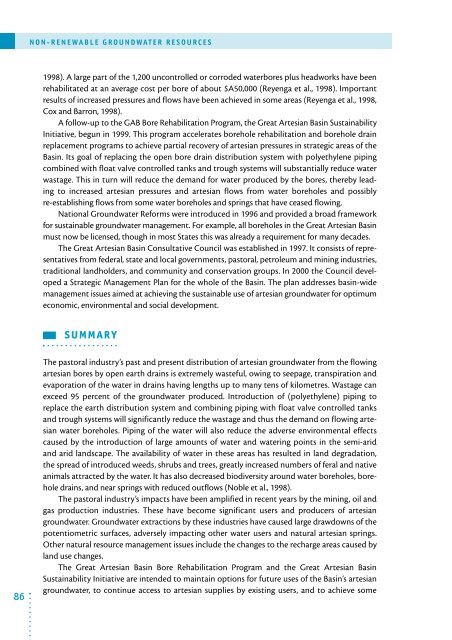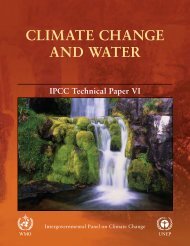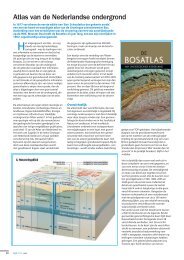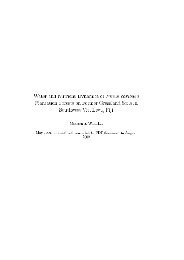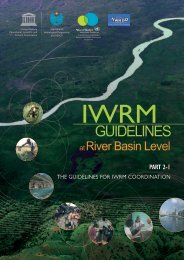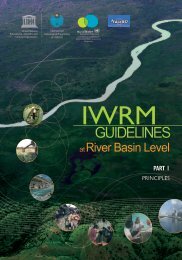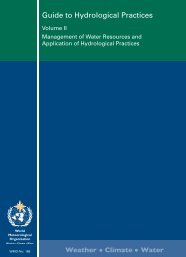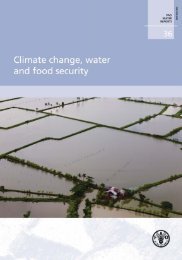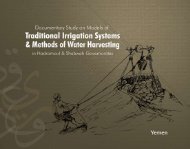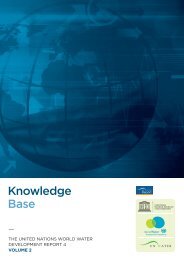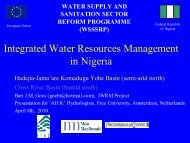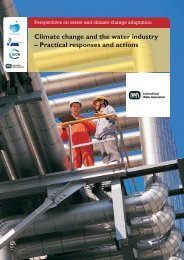Non-renewable groundwater resources: a ... - unesdoc - Unesco
Non-renewable groundwater resources: a ... - unesdoc - Unesco
Non-renewable groundwater resources: a ... - unesdoc - Unesco
- No tags were found...
Create successful ePaper yourself
Turn your PDF publications into a flip-book with our unique Google optimized e-Paper software.
NON-RENEWABLE GROUNDWATER RESOURCES1998). A large part of the 1,200 uncontrolled or corroded waterbores plus headworks have beenrehabilitated at an average cost per bore of about $A50,000 (Reyenga et al., 1998). Importantresults of increased pressures and flows have been achieved in some areas (Reyenga et al., 1998,Cox and Barron, 1998).A follow-up to the GAB Bore Rehabilitation Program, the Great Artesian Basin SustainabilityInitiative, begun in 1999. This program accelerates borehole rehabilitation and borehole drainreplacement programs to achieve partial recovery of artesian pressures in strategic areas of theBasin. Its goal of replacing the open bore drain distribution system with polyethylene pipingcombined with float valve controlled tanks and trough systems will substantially reduce waterwastage. This in turn will reduce the demand for water produced by the bores, thereby leadingto increased artesian pressures and artesian flows from water boreholes and possiblyre-establishing flows from some water boreholes and springs that have ceased flowing.National Groundwater Reforms were introduced in 1996 and provided a broad frameworkfor sustainable <strong>groundwater</strong> management. For example, all boreholes in the Great Artesian Basinmust now be licensed, though in most States this was already a requirement for many decades.The Great Artesian Basin Consultative Council was established in 1997. It consists of representativesfrom federal, state and local governments, pastoral, petroleum and mining industries,traditional landholders, and community and conservation groups. In 2000 the Council developeda Strategic Management Plan for the whole of the Basin. The plan addresses basin-widemanagement issues aimed at achieving the sustainable use of artesian <strong>groundwater</strong> for optimumeconomic, environmental and social development.SUMMARY86The pastoral industry’s past and present distribution of artesian <strong>groundwater</strong> from the flowingartesian bores by open earth drains is extremely wasteful, owing to seepage, transpiration andevaporation of the water in drains having lengths up to many tens of kilometres. Wastage canexceed 95 percent of the <strong>groundwater</strong> produced. Introduction of (polyethylene) piping toreplace the earth distribution system and combining piping with float valve controlled tanksand trough systems will significantly reduce the wastage and thus the demand on flowing artesianwater boreholes. Piping of the water will also reduce the adverse environmental effectscaused by the introduction of large amounts of water and watering points in the semi-aridand arid landscape. The availability of water in these areas has resulted in land degradation,the spread of introduced weeds, shrubs and trees, greatly increased numbers of feral and nativeanimals attracted by the water. It has also decreased biodiversity around water boreholes, boreholedrains, and near springs with reduced outflows (Noble et al., 1998).The pastoral industry’s impacts have been amplified in recent years by the mining, oil andgas production industries. These have become significant users and producers of artesian<strong>groundwater</strong>. Groundwater extractions by these industries have caused large drawdowns of thepotentiometric surfaces, adversely impacting other water users and natural artesian springs.Other natural resource management issues include the changes to the recharge areas caused byland use changes.The Great Artesian Basin Bore Rehabilitation Program and the Great Artesian BasinSustainability Initiative are intended to maintain options for future uses of the Basin’s artesian<strong>groundwater</strong>, to continue access to artesian supplies by existing users, and to achieve some


